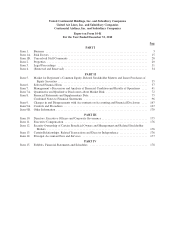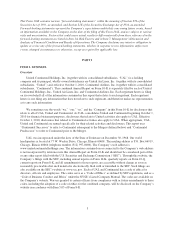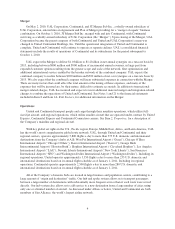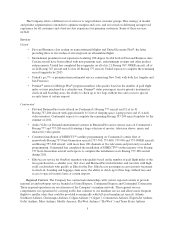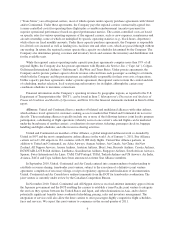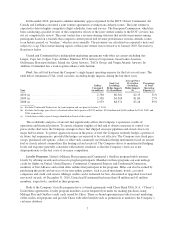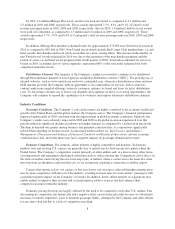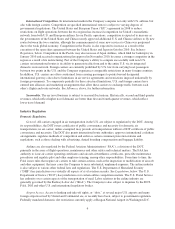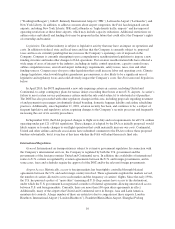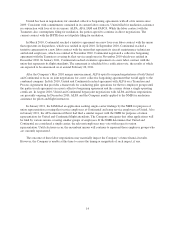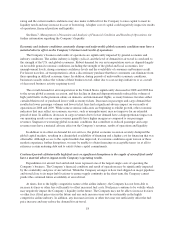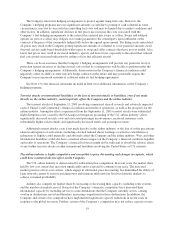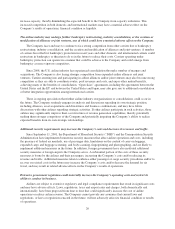United Airlines 2010 Annual Report Download - page 13
Download and view the complete annual report
Please find page 13 of the 2010 United Airlines annual report below. You can navigate through the pages in the report by either clicking on the pages listed below, or by using the keyword search tool below to find specific information within the annual report.International Airport, Beijing Capital International Airport, Sao Paulo Guarhulos International Airport and Tokyo
Narita International Airport are among the most restrictive airports due to capacity limitations. United and
Continental have significant operations at these locations.
The Company’s ability to serve some foreign markets and expand into certain others is limited by the
absence of aviation agreements between the U.S. government and the relevant foreign governments. Shifts in
U.S. or foreign government aviation policies may lead to the alteration or termination of air service agreements.
Depending on the nature of any such change, the value of the Company’s international route authorities and slot
rights may be materially enhanced or diminished.
The U.S./EU open skies agreement provides U.S. and EU carriers with expansive rights, including the right
to operate between any point in the United States and the EU. The agreement has no direct impact on airport slot
rights or airport facilities nor does it provide for a reallocation of existing slots or facilities, including those at
London Heathrow. Because of the diverse nature of potential impacts on the Company’s business, the overall
future impact of the U.S./EU agreement on the Company’s business cannot be predicted with certainty.
In October 2010, the open skies agreement between the United States and Japan became effective, enabling
U.S. or Japanese carriers to fly between any point in the United States and any point in Japan and, in the case of
U.S. carriers, beyond Japan to points in other countries the carrier is authorized to serve. The agreement
eliminates the restrictions on the number of frequencies carriers can operate and requires governments in both the
United States and Japan to concur before taking action to regulate a carrier’s fares or rates.
Environmental Regulation.
General. The airline industry is subject to increasingly stringent federal, state, local and international
environmental laws and regulations concerning emissions to the air, discharges to surface and subsurface waters,
safe drinking water, aircraft noise, and the management of hazardous substances, oils and waste materials. Areas
of developing regulations include new regulations surrounding the emission of greenhouse gases (discussed
further below), State of California rule-makings regarding air emissions from ground support equipment, and a
federal rule-making concerning the discharge of deicing fluid.
Climate Change. There are certain laws and regulations relating to climate change that apply to the
Company, including the EU Emissions Trading Scheme (“ETS”) (which is subject to legal challenge),
environmental taxes for certain international flights (including the United Kingdom’s Air Passenger Duty and
Germany’s departure ticket tax), limited greenhouse gas reporting requirements, and the State of California’s cap
and trade regulations (which impacts United’s San Francisco Maintenance Center and co-located cogeneration
plant). In addition, there are land-use planning laws that could apply to airport expansion projects, requiring a
review of greenhouse gas emissions, and could affect airlines in certain circumstances.
In 2009, the EU issued a directive to member states to include aviation in its greenhouse gas ETS, which
required the Company to begin monitoring emissions of carbon dioxide effective January 1, 2010. Beginning in
2012, the ETS would require the Company to ensure it has obtained sufficient emission allowances equal to the
amount of carbon dioxide emissions from flights to and from EU member states with such allowances then
surrendered on an annual basis to the government. In December 2009, the Air Transportation Association, joined
by United, Continental and American Airlines, filed a lawsuit in the United Kingdom challenging regulations that
transpose into UK law the EU ETS as applied to U.S. carriers. In addition, non-EU countries are considering
filing a formal challenge before the United Nations’ International Civil Aviation Organization (“ICAO”) with
respect to the EU’s inclusion of non-EU carriers. If the scheme is found to be valid, it could significantly increase
the cost of carriers operating in the EU (by requiring the purchase of carbon credits), although the precise cost to
the Company is difficult to calculate with certainty due to a number of variables. Those potential costs will
depend, among other things, on the baseline carbon emissions yet to be determined by the EU, the Company’s
future carbon emissions from flights to and from the EU, and the price of carbon credits.
11


